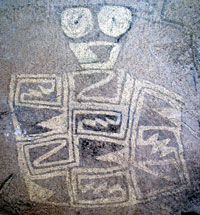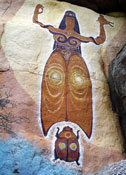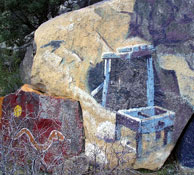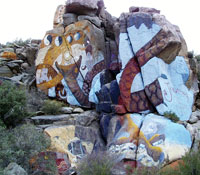|
Rock
Art
Early people did not spend all their time looking for food. They had time to play games, tell stories and make things. They used rock to make art and share their ideas. Many examples of early rock art survive today. Ancient rock art is found around the world. The rock art tells us stories, reveals beliefs and ceremonies, and relates the history of the people who created the images. |
|||||||||||
|
Southwestern US Rock Art Ancient rock art can be found everywhere in North America. Tens of thousands of rock art sites are found in the Southwest. The pictures that were pecked or painted on boulders and cliffs are referred to as primitive art. However, they were also a way to communicate ideas. Like today's road signs and cartoons, their messages convey ideas. These ancient images are found whereever early people lived and worked such as above stone shelters, inside caves, near water sources, game trails, and gathering spots. |
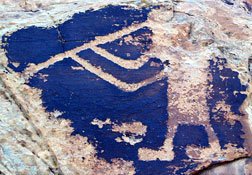 |
||||||||||
|
|||||||||||
|
The pictures were created for many reasons such as marking places, showing rituals and battles, or just for pleasure. They provide a visual history. Pictograph or Petroglyph - What's the Difference? There are two types of rock art: petroglyphs and pictographs. Petroglyphs are pecked, ground, or scratched into the rock surface. Petro is Greek for rock and glyph means drawing. Many petroglyphs are found on rock varnish (photo above right). You can find petroglyphs in many places where the rock can be carved (Inscription Rock shown photo below). Rock tools were used to chip the images into the stone. |
|||||||||||
|
|
|||||||||||
|
Ancestral
Puebloan petroglyph, 'Inscription Rock', El Morro National Monument,
New Mexico
|
|||||||||||
|
|
Pictographs are paintings or drawings made on rock. They were completed in one or more colors. The colors were made from mineral pigments and natural dyes from plants. Pictographs were easier to make than petroglyphs. They tend to contain more complex designs than petroglyphs (photo on left). However pictographs are also more fragile. The ones that survived are in protected areas such as underneath rock overhangs. Many rock art images used a combination of both techniques. However, today the paint material has faded, flaked, or washed away. |
||||||||||
|
Ancestral
Puebloan pictograph, Tlaloc Figure
|
|||||||||||
| Hueco Tanks Historical Park, El Paso Co. Texas | |||||||||||
|
Cultures, Styles, and Age of Rock Art Many cultures are represented in Southwestern US rock art sites. These include:
|
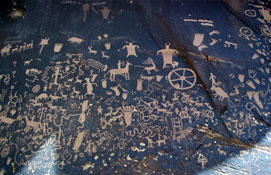 |
||||||||||
|
Newspaper
Rock State Historic Site. SE Utah
|
|||||||||||
| Rock drawing did not end with the arrival of Europeans. In fact, pictures of horses, hats, wheels were just added to the artwork. Some rock art sites have been used for thousands of years. For example, Newspaper Rock in Utah has hundreds of figures from a number of cultures (photo above right). The huge panel is protected by a natural overhang. Today a security railing prevents vandalism. | |||||||||||
|
Southwestern rock art is often composed of three kinds of art. These include human-like, animal-like, and abstract figures. Other pictures such as plants, masks, and maps can also be found. It is difficult to find the age of rock art. Scientists look for clues. For example, if bows and arrows are shown, the date is after 500 AD. Horses were brought by the Spaniards after 1540 AD. |
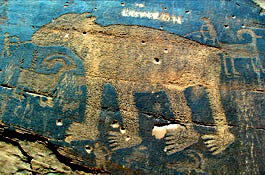 |
||||||||||
|
Potash
Road (Hyway 279), Near Moab, Utah
|
|||||||||||
|
There are other ways to find the age of rock art.
|
|||||||||||
 |
Rock Art of Today People still make rock art today. The work of artists (photo on left) can be found in shops and at craft fairs. In the Southwest, descendants of ancient people create and sell rock art that looks like ancient pictographs and petroglyphs. The three photographs (below) show Navajo folk artists, Antonio C. and D. Denny, of Chinle, Arizona with their artwork. |
||||||||||
 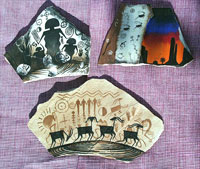 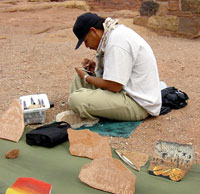 |
|||||||||||
| In
northeastern Arizona are the rock
murals of artist Roy Pucell (photos below). This modern rock art from
the 1960s includes scenes of weathered buildings, ghost towns, landscapes,
and symbolic figures. The colors in the murals are still bright after
almost forty years. There are also ancient pictures nearby.
More Information Rock art sites are found on private, state, federal, and Native American tribal lands. All ancient rock art sites are protected areas. Take care of them. The sites are extremely fragile and can never be replaced. Never touch the rock surfaces. Take care when walking around rock art sites.
More Information Note:
All photographs were taken with a digital camera in Arizona, New Mexico,
Texas, and Utah. |
|||||||||||

